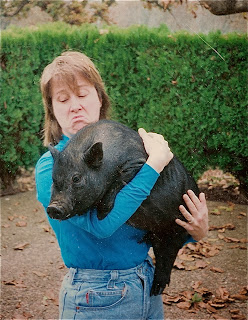 |
| Nelson, the adorable neighbor child in question |
Childhood diseases are not supposed to be funny, even if they result in explosive diarrhea. So it’s not polite to snort when your neighbor tells you her kid has Hand, Foot, and Mouth disease. Even if she explains that it’s caused by a Coxsackie virus. I managed to contain most of my fluids while remarking that I had never heard of Hand, Foot, and Mouth disease. Sure enough, it’s younger than I am. It was originally described in 1957 in New Zealand, and although there is no good reason for anyone to leave New Zealand, eventually someone did and it got out.
We never really have a virulence shortage. If viruses seem to be flagging, they hold a convention and run a few numbers through a trial population of monkeys, pigs, or chickens. Or possibly kiwis. Hand, Foot, and Mouth disease is so named because it presents with blisters on the hands, feet, mouth, and fanny, and some people still know how to show restraint. The name is, at least, descriptive, which is more than can be said for Fifth disease.
I’d never heard of that one, either, although it’s been around for a while. Fifth disease used to be called “Slapped Cheek” syndrome because it looked as though the child’s face had been slapped. Nowadays it is popularly referred to as “Repeatedly Fell Face First Onto The Coffee Table, Officer” syndrome, or (formally) “Plead The Fifth” disease. Anyway, it’s viral too. Supposedly over half of children have had it by age 19, although, since many of them exhibit no symptoms at all, I suspect the statisticians are just using the disease to make it look like they’ve been busy.
 |
| This is flu. |
A virus is often defined as a small infectious agent, but that’s like defining cows as standing leather. It may be true, but it’s disrespectful and anthropocentric. A virus is a perfectly interesting little bundle of protein with hopes and dreams of its own. Some people consider them to be less than living things, but for all that they have a lot of zip, even making trips around the world. The thing that lowers the status for viruses in the minds of some is that they do not actually have their own metabolism and require a host cell to get anything done at all. I, too, am small and use a similar life strategy, at least as regards being fed, so I am more sympathetic to their condition.
If one were to step back from the human-centered perspective, it could be said that the function of people is to give viruses a moist, warm spot to land. This certainly gives them more credit for their general success, and reflects well on us, too. There are a number of ways viruses transport themselves, many of them involving a spewing aspect. The host’s body reacts to the invasion (or “visit”), spewing happens, and bingo, your virus is a going concern. We are merely their transportation infrastructure. One of the more successful means of transmission is called the “fecal-oral route.”
That sucker really ought to be one-way.


Ewww! Gross picture of a sneeze, showing why riding the bus can be hazardous to my health. Hope the adorable neighbor child gets better soon; that's an awful moniker to have to carry around when you're that small. 🙂
He's tough though. He could be like Hercules: pick up a little virus every day until he's grown and he can lift a whole pandemic.
Yeah, I have been pretty human centric in my view of viruses. Thank you for pointing that out. Not that my viewpoint is going to change, mind you, but at least I am more self-aware.
By the way, in the antipodes, "fanny" is a rude slang term for a woman's vagina. If the kid from New Zealand has blisters, he has them on his bum. Now you know why the kiwis sniggered when you got out your fanny pack.
That's just wrong. Fanny is such a nice word, where it belongs.
Were you perchance hosting the flu virus whilst exhibiting such a degree of respect to the little ruggers?
I'm just a naturally respectful person. Yeah, that's it. Got my very first flu shot yesterday!
Humans are the Interstates of viruses and many bacteria. We could boil ourselves for ten minutes and not even be close to ridding ourselves of all the hitchhikers along for the ride. Yuck!
That's why I sometimes like to refer to myself as "we." The bacterial "we."
Viruses are interesting: they do not actually fit the definition of alive and thus you can't kill them.
As far as kids go: they are nasty little buggers: they carry and spread all kinds of germs – best to stay away from them when you can.
the Ol'Buzzard
We always did, but since we got a little critter in our family (now two), Dave and I have turned into baby-oglers. Who knew?
I wish someone had thought up the "sneeze into your elbow" system when we were kids. I wish everyone used it. And now that you are baby-oglers, do you wash your hands every three minutes or so? I don't have OCD, I just have grandchildren. Cheers.
Oh, we're oglers. We don't touch. They're leaky.
Spewing Happens. That should be a bumper sticker.
True dat. And dat's why we're oglers only.
If I am remembering correctly, I think this used to be called "hoof and mouth disease". When did the name become less animalistic? We are living with 3 grandchildren in our home…a true viral factory.
Not the same disease. Tusk, Nostril, and Antler is different, too.
This comment has been removed by the author.
Poor piggy. I assume that was a passing pictorial reference to swine flu?
Your neighbour child is a cutie.
Nelson IS! Plus, he's halfway to having size 14 feet. The boy will never fall over.
Sweet baby!
Now I have to look up Hand, Foot and Mouth disease so I know what to watch out for. Sounds similar to impetigo, which goes by the more common name of school sores out here. I haven't heard of a case of that since I was in primary school and several kids had it.
Impetigo. One of those things I've heard of but don't know what it is. Sounds like that thing Michael Jackson insisted he had. But maybe that was Quasimodo.
No, that was vitiligo. Same thing I have.
(Vitiligo is a skin condition in which there is a loss of brown color (pigment) from areas of skin, resulting in irregular white patches that feel like normal skin.)
So the thing I didn't quite get about Michael Jackson is why, if he got white patches, he decided to go with that for an all-over look, when it probably would have been easier to put brown makeup on the white patches. Not my business, however.
one of my daughters has vitiligo, along with another skin condition I don't remember the name of which causes darker pigmentation areas, so she looks a little patchy without makeup.
I googled hand, foot and mouth disease, it looks terribly painful and similar to impetigo.
I'm more inclined to have foot IN mouth disease.
In the beginning was the Virus. I am also convinced that viruses are the summit of evolution. The rest of us are here to provide food, shelter, warmth, and sex for them. Not even roaches can approach them.
I am not providing sex for them without my usual fee.
The problem, Murr, is that you're such a neat person, that every virus in the neighbourhood wants to come to visit you. You who'd considered yourself flattered by that.
Blessings and Bear hugs!
Actually I'm kind of a sloppy person, but viruses like that too. Do you ever get Bear hugs back? Here's one.
If only there was a cloak to fit, viruses would make perfect super heroes (or super villians). Even kryptonite doesn't faze them.
Just our luck, virus cloaks would turn out to be virulent all by themselves.
What I don't get about Fifth Disease (even though I did get the actual disease and I realize I'm repeating myself) is what lazy scientist named it? Just a number? How uncreative!
Here's the scoop. In the nineteenth century, there were several diseases that caused a rash, and they started numbering them. Measles was Oneth, and Scarlet Fever was Twoth. All the other numbers got dropped but no one came up with anything better for Fifth than Fifth.
Well, thank you ma'am! Now I know the rest of the story. It's less of an odd name now that I know the reason.
I had impetigo once when I was about 8. My cousin with whom I was spending a few days had an open sore that had it and of course I had to fall down and scratch my knee and by the time I went home, my leg looked like a terrible mess. Cured it with some sort of magic potion that our favorite nurse gave me.
You and your cousin did one of those open-knee-sore friendship oaths, didn't you? Wait. Are there pus oaths?
not intentionally
I am HYSTERICAL laughing at this:
"Fifth disease used to be called "Slapped Cheek" syndrome because it looked as though the child's face had been slapped. Nowadays it is popularly referred to as "Repeatedly Fell Face First Onto The Coffee Table, Officer" syndrome, or (formally) "Plead The Fifth" disease."
BAhhHhHAhhAHHA!
You're easy, meleah! I like that in a person.
Nice viro-centric stuff here (I wrote a book about viruses long ago).
I'm so eager for humans to get over themselves that I'll take any other perspective. Nice to meet you, Andrew.